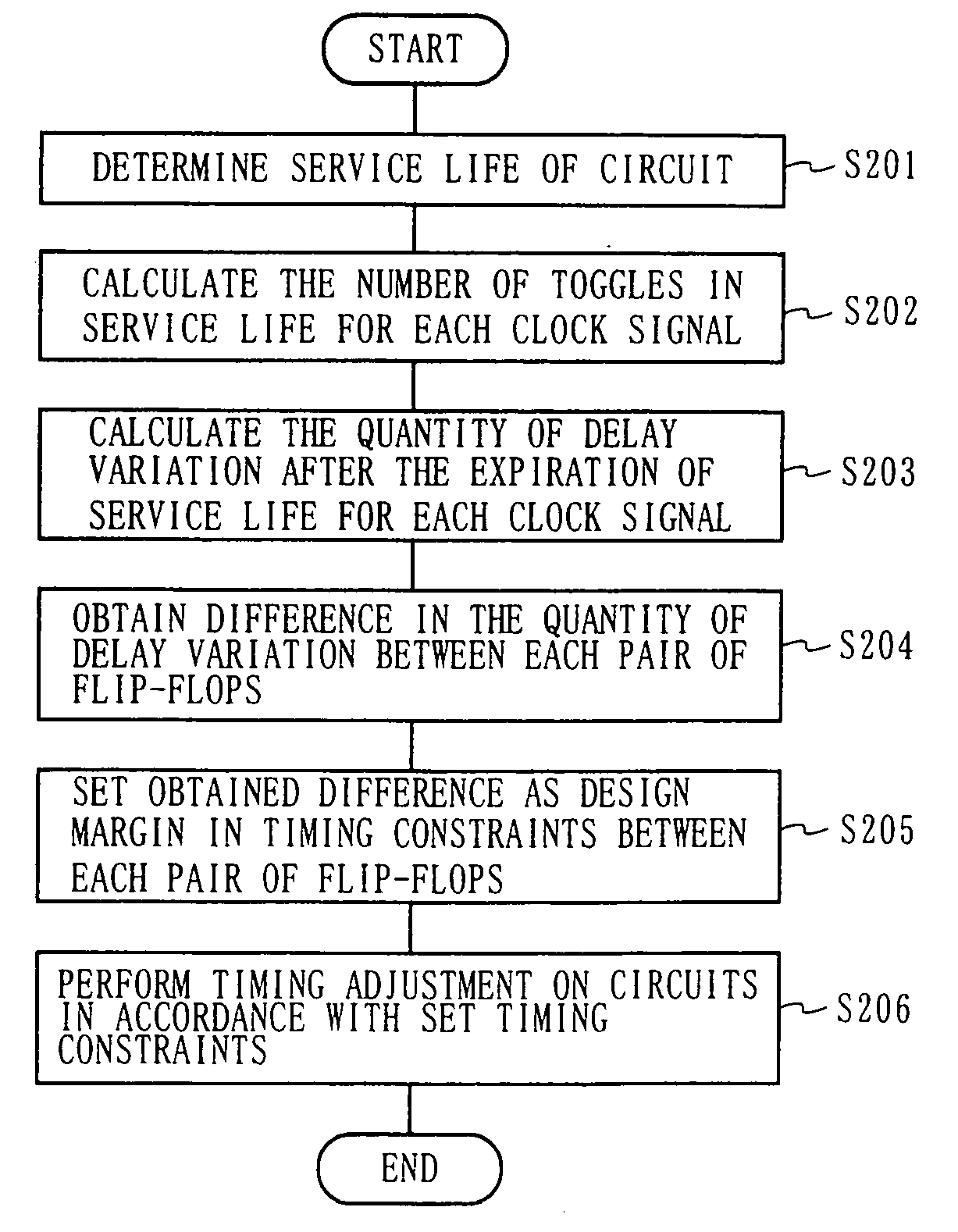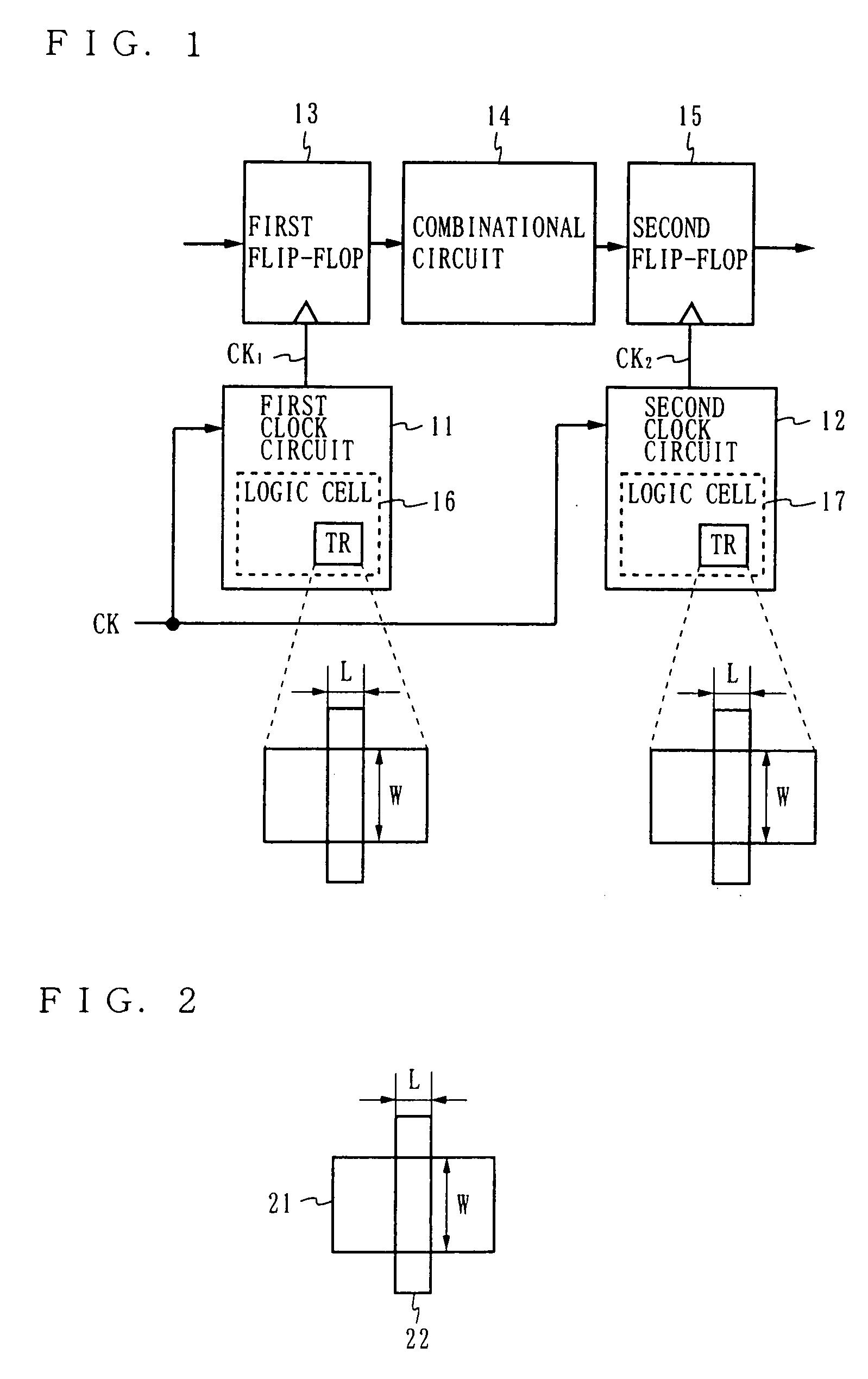Semiconductor integrated circuit and method for designing same
a technology of integrated circuits and semiconductors, applied in the direction of generating/distributing signals, total factory control, instruments, etc., can solve the problem of tens of more time than expected, and achieve the effect of accurate setting of design margins, reducing circuit size, and high accuracy
- Summary
- Abstract
- Description
- Claims
- Application Information
AI Technical Summary
Benefits of technology
Problems solved by technology
Method used
Image
Examples
first embodiment
[0049] A first embodiment of the present invention is described with respect to a semiconductor integrated circuit in which logic cells included in clock circuits are formed by transistors of a unified size. FIG. 1 is a diagram showing the structure of the semiconductor integrated circuit according to the present embodiment. The semiconductor integrated circuit shown in FIG. 1 includes a first clock circuit 11, a second clock circuit 12, a first flip-flop 13, a combinational circuit 14, and a second flip-flop 15. Each of the first and second flip-flops 13 and 15 operates in synchronization with a clock signal CK supplied thereto. Specifically, the first clock circuit 11 generates a first clock signal CK1 based on the clock signal CK, and the first flip-flop 13 operates in synchronization with the first clock signal CK1. The second clock circuit 12 and the second flip-flop 15 operate similar to the first clock circuit 11 and the first flip-flop 13, respectively. The combinational cir...
second embodiment
[0062] A second embodiment of the present invention is described with respect to a design method which uses a circuit block, which is designed to operate under a prescribed operating condition, to design a semiconductor integrated circuit so as to operate under an operating condition different from that of the circuit block. Described first is a design method which uses a circuit block, which is designed to operate at a prescribed threshold voltage, to design a semiconductor integrated circuit so as to operate at a threshold voltage different from that of the circuit block (see FIG. 6). A semiconductor integrated circuit 30 shown in FIG. 6 includes an upstream clock circuit 31, a circuit block 32, a second downstream clock circuit 35, and a second flip-flop 36. The semiconductor integrated circuit 30 is designed to operate at a prescribed threshold voltage (hereinafter, referred to as a “second threshold voltage VT2”). The circuit block 32 includes a first downstream clock circuit 3...
third embodiment
[0070] A third embodiment of the present invention is described with respect to a method for designing a semiconductor integrated circuit which takes account of variations in delay time of clock signals due to deterioration over time of transistors. In general, a transistor deteriorates depending on the length of time periods for which a prescribed signal voltage is applied thereto. Accordingly, a delay time of a circuit formed by transistors is increased with the passage of time. In most cases, the length of a time period for which a clock signal is at a high level is the same as the length of a time period for which the signal is at a low level. Accordingly, by counting the number of times when the clock signal is changed to a prescribed value (hereinafter, referred to as the “number of toggles”), it is possible to calculate the length of time periods for which the clock signal is at the prescribed value, whereby it is possible to previously estimate how much deterioration occurs ...
PUM
 Login to view more
Login to view more Abstract
Description
Claims
Application Information
 Login to view more
Login to view more - R&D Engineer
- R&D Manager
- IP Professional
- Industry Leading Data Capabilities
- Powerful AI technology
- Patent DNA Extraction
Browse by: Latest US Patents, China's latest patents, Technical Efficacy Thesaurus, Application Domain, Technology Topic.
© 2024 PatSnap. All rights reserved.Legal|Privacy policy|Modern Slavery Act Transparency Statement|Sitemap



